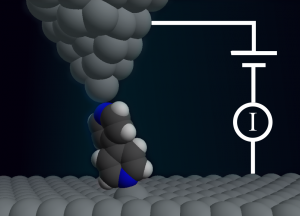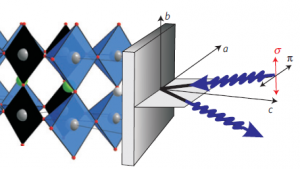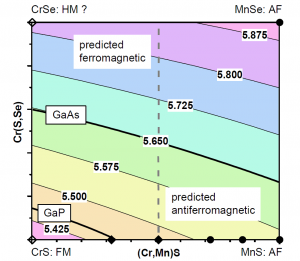- Modelling realistic spintronic devices
 Over the last 15 years many new effects connecting charge and spin transport of electrons have been identified which harness relativistic spin-orbit coupling to create spin currents in non-magnetic materials. Recently, these effects have been realised in real devices such as magnetic random access memories (MRAM). In our work, we theoretically model these effects in real devices, taking into account disorder, interfaces, and finite temperatures from first principles. In order to achieve this, we develop bespoke in house computer codes describing the relativistic electronic structure and apply this to devices actually measured by our collaborators.
Over the last 15 years many new effects connecting charge and spin transport of electrons have been identified which harness relativistic spin-orbit coupling to create spin currents in non-magnetic materials. Recently, these effects have been realised in real devices such as magnetic random access memories (MRAM). In our work, we theoretically model these effects in real devices, taking into account disorder, interfaces, and finite temperatures from first principles. In order to achieve this, we develop bespoke in house computer codes describing the relativistic electronic structure and apply this to devices actually measured by our collaborators.- Supervisor(s)
- Dr. Martin Gradhand, University of Bristol
- Single molecule electronics
 Single molecule electronics represents the ultimate in miniaturization, where circuit elements are replaced by individual molecules. It is already possible to contact individual molecules electrically using a scanning probe microscope to measure their conductance. It is even possible to make them act like a transistor by gating them electrochemically. Single or few-molecule devices are unlikely to replace circuits based on inorganic semiconductors any time soon, but they already have properties that make them of interest for sensors. Furthermore the physics involved in charge and spin transport through molecules and across their contacts is fascinating, and much remains unknown. Within the CDT-CMP, we offer projects probing new aspects of single molecule electronics exploiting our unique experience of working with magnetic metal and semiconductor contacts. This enables us to go beyond single molecule electronics to probe spintronic and photoelectronic effects
Single molecule electronics represents the ultimate in miniaturization, where circuit elements are replaced by individual molecules. It is already possible to contact individual molecules electrically using a scanning probe microscope to measure their conductance. It is even possible to make them act like a transistor by gating them electrochemically. Single or few-molecule devices are unlikely to replace circuits based on inorganic semiconductors any time soon, but they already have properties that make them of interest for sensors. Furthermore the physics involved in charge and spin transport through molecules and across their contacts is fascinating, and much remains unknown. Within the CDT-CMP, we offer projects probing new aspects of single molecule electronics exploiting our unique experience of working with magnetic metal and semiconductor contacts. This enables us to go beyond single molecule electronics to probe spintronic and photoelectronic effects- Supervisor(s)
- Professor Walther Schwarzacher, University of Bristol
- Collective spin excitations measured with resonant inelastic X-ray scattering
 Resonant inelastic x-ray scattering (RIXS) is a new technique to measure collective magnetic excitations in solids such antiferromagnets, quantum magnets and superconductors. RIXS offers the possibility to study collective electronic excitations up to high energies (~eV) with a resolution of tens on meV on samples of size 10 micrometres. State-of-the-art new RIXS spectrometers are available at the Diamond light source in the UK and the ESRF in France. We apply RIXS and neutron scattering techniques to study the collective magnetic excitations in topical systems such as iron-based and cuprate superconductors, frustrated magnets, and magnetic transition-metal oxide systems.
Resonant inelastic x-ray scattering (RIXS) is a new technique to measure collective magnetic excitations in solids such antiferromagnets, quantum magnets and superconductors. RIXS offers the possibility to study collective electronic excitations up to high energies (~eV) with a resolution of tens on meV on samples of size 10 micrometres. State-of-the-art new RIXS spectrometers are available at the Diamond light source in the UK and the ESRF in France. We apply RIXS and neutron scattering techniques to study the collective magnetic excitations in topical systems such as iron-based and cuprate superconductors, frustrated magnets, and magnetic transition-metal oxide systems.- Supervisor(s)
- Professor Stephen Hayden, University of Bristol
- New transition metal monochalcogenides
 There have been many attempts to introduce magnetism into semiconductors, but the search is still on for room temperature ferromagnetic materials compatible with semiconductor electronics. The figure shows density functional theory (DFT) predictions of magnetic phases of thin layers of new transition metal chalcogenides (not found in nature) being grown by molecular beam epitaxy by collaborators at Heriot-Watt University. Optical spectroscopy, Raman scattering, magneto-optics and charge transport studies (with Prof. Simon Bending, Bath) are being used to investigate these materials, along with DFT simulations.
There have been many attempts to introduce magnetism into semiconductors, but the search is still on for room temperature ferromagnetic materials compatible with semiconductor electronics. The figure shows density functional theory (DFT) predictions of magnetic phases of thin layers of new transition metal chalcogenides (not found in nature) being grown by molecular beam epitaxy by collaborators at Heriot-Watt University. Optical spectroscopy, Raman scattering, magneto-optics and charge transport studies (with Prof. Simon Bending, Bath) are being used to investigate these materials, along with DFT simulations.- Supervisor(s)
- Dr. Daniel Wolverson, University of Bath
